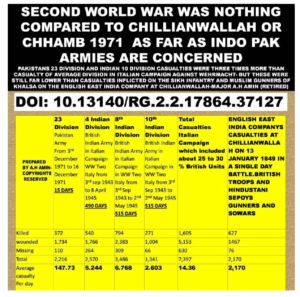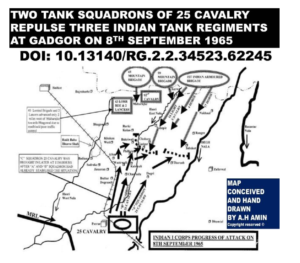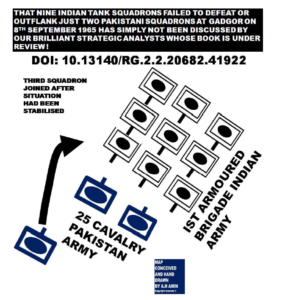This is Major Amin’s review of “Limited War in South Asia”
In 2018 when I saw this book by Kaushik Roy I was surprised since to my mind Kaushik Roy does very well with archives and records but is not a real military historian who understands hard core military matters.
I therefore decided to procure this book and read it , and find out what Mr Kaushik Roy has found out.
Below is my review of Kaushik Roy and Scott Gates book.
The maps which are published at the start of the book are poorly drawn, inaccurate and impossible to understand as the scale is too small.A serious failing for a book published by a publisher as eminent as Routledge as late as 2017 !
For example all Pakistani formations are marked incorrectly although the Pakistani order of battle is known worldwide.This is a simply inexcusable failure.
Like Pakistan’s 1 Corps is marked as 2 Corps while Pakistan’s 2 Corps is marked as 1 Corps and even its dispositions are not marked accurately.
Further the map invents a new corps which has never existed in the Pakistan Army, ie 3 Corps.Thus Lahore’s 4 Corps is shown as 3 Corps.
The writer magnifies the role of Indian Army in North Africa and Italy while in reality in both theaters Indian Army was part of a much larger British Australian New Zealand South African American force and enjoyed massive numerical superiority in both theaters. Thus Indian Army casualties in North Africa were very low and the same was the case in Italy.In most ways the Indian Army learnt little about higher command as British Indian Army was never trusted with major offensive operations. The brigade and divisional commanders were always British and each Indian brigade had one British infantry unit.

On page-8 it is stated that PAVO Cavalry (my regiment) had Stuart tanks at Secunderabad , whereas as per my research and 11 Cavalry regimental history PAVO Cavalry had shifted from Stuart to Sherman V tanks.
On page-9 the authors claim that experience of 4th Armoured Division in Africa helped Indian and Pakistan Army in armour operations in 1965 war , but this sweeping assertion is not supported by hard facts of 1965 war where performance of both Indian and Pakistan Army tanks was pathetic in offensive operations.
Both armies armour leadership was so poor that both armies failed to achieve a break through despite 5 to 1 superiority in tanks in case of Indian Army in Sialkot and 7 to 1 superiority in tanks in case of Pakistan Army at Assal Uttar.
The book makes inexcusable factual errors that are simply unforgivable. Like on page-10 General Cariappa is stated to be Indian Army COAS from 1962 to 1966 whereas he was Indian Army COAS from 1949 to 1953.
On page-34 the writers failed to note that Indian 163 Brigade Commander ordered a two day rest during the march to Tithwal in the first Kashmir war, as a result of which as per Pakistani official history of Kashmir War the Indians lost a golden chance to capture Muzaffarabad as Pakistanis in these two days reinforced the single infantry company at Tithwal with an infantry brigade.
The Pakistani official history of Kashmir war titled the Kashmir Campaign described the impact of Brigadier Harbaksh Singh’s two day halt as below :–
Brigadier Harbux Singh Commander of the 163 Brigade waited at Tithwal for two days………..He lingered a little longer to prepare for his next move and to perhaps also coordinate his moves with that of Indian offensive in Jhelum Valley for a two pronged push towards Muzaffarabad. The delay changed the subsequent course of history in the Kishanganga Valley…..” (Refers page-144-The Kashmir Campaign-1947-48-Historical Branch-General Headquarters-Pakistan Army-December 1970).
The authors fallaciously claim on page-34 that there were two battalions of Pathans defending Zojila Pass. In reality Zojila was defended by a ragged mix of Gilgit Scouts and Baltistan volunteers and there were absolutely no Pathans at Zojila. Their strength did not exceed 500 to 600 men , what to talk of two battalions.
On page-35 our eminent writers exhibit their absolute ignorance of basic geography when they make statements which are geographically absolutely fallacious and incorrect. For example, they claim that there was a Pakistani para brigade threatening communications between Amritsar and Jammu and Pathankot and Poonch. Both these assertions are absolutely false.
The Pakistani 14 Para Brigade was threatening Indian communications between Akhnoor and Punch and not Patahnkot and Poonch or Amritsar and Jammu as fallaciously claimed in this work. which makes a highly inflated claim to be a work of Military Art and Operational Strategy.
Our operational strategists cannot produce one decent, legible and factually correct map and their narrative does not relate with geography !
The authors description of Operation Grand Slam is absolutely inaccurate and confused, although they quote from 11 Cavalrys history of Colonel Effendi , it seems that they did not completely read the book !
Our operational strategy historians thus only describe conduct of 11 Cavalry’s C Squadron and totally forget that 11 Cavalry had three squadrons and its B Squadron reached Tawi river near Chamb 0830 Hour morning of first day of the attack.
The account totally omits all operations of Operation Grand Slam from Tawi River till Akhnur which had strategic significance.
On page 74 the writers cannot even accurately describe the order of battle of Pakistan’s 6 Armoured Division and state that it consisted of 11 Cavalry and 22 Cavalry whereas in reality the division had Guides Cavalry, 11 Cavalry and 22 Cavalry. The account of the most crucial battle of Indo Pak war is pathetically short, incomplete and absolutely vague (page-75).
In this battle THREE Indian tank regiments confronted two tank squadrons of Pakistans 25 Cavalry. They suffered serious tank losses and Indian 1st Armoured Brigade commander losing resolution and magnifying dangers in front of him ordered withdrawal to Tharoah cross roads.
But our brilliant strategists describe this massive affair as below :–
“after the initial melee on 8 september the Indian 1st Armoured Division established a laager behind Phillora Division” .
This is an absolute apology of how military history is written.
Map below illustrates the massive action of 8th September and the subsequent Indian actions:–


On page 75 the authors incorrectly claim that Indian 1st Armoured Division withdrew behind Phillora since Indian 1st Armoured Division far ahead of Phillora towards Sabzpir . Thereafter no other action of Indian 1st Armoured Division is discussed although this division as well as its supporting infantry divisions fought some very major battles from 8th to 22 September 1965.
On page 78 the authors claim that Major General Attiq ur Rahman was sent as Deputy Corps Commander 1 Corps. This matter is nowhere mentioned in two books that Musa Khan wrote. Only the book of Lt Gen Mahmud states that Atiq visited 1 Corps HQ as Adjutant General.
Pakistan Armys official account by Major General Shaukat Riza states that Major General Sahibzada Yaqub was posted as Deputy Corps commander 1 Corps.
The authors treatment of Pakistans 1st Armoured Divisions operations on page 78 etc is extremely sketchy. They fail to note that 1st Armoured failed to concentrate into Indian territory on 7th and 8th September 1965 because of failures linked to Pakistani inefficiency rather than any Indian actions.
No map illustrates the Khem Karan battles which is a major failure of this book.
The treatment of 1971 war is again full of mistakes.
Like on page 107 some real assorted nonsense claims are made regarding Pakistan Army orbat in Kashmir like stating that 23 Division was responsible for Kotli Poonch area whereas 23 Division had absolutely nothing to do with Poonch which was in area of responsibility of 12 Division.
Further it is fallaciously claimed on the same page that 8 Independent Armoured Brigade was part of 4 Corps Lahore although this brigade had nothing to do with 4 Corps.
Page-108 leads me to the conclusion that this book was an absolute disaster and the editors need to be hanged upside down. I had a very high opinion about Routledge till I read this absolute disaster, if one can call it a book !
The authors on this page made some very fallacious and totally non factual claims.They term attack by Pakistans 23 Division as attack by Pakistans 2 Corps , which one can term as absolute nonsense . I could not imagine that so called researchers could be so ill informed . Anyhow the whole attack by Pakistans 23 Division is described as an attack by Pakistans 2 Corps under Tikka Khan which is ludicrous and an absolute travesty of facts.
I am surprised how this book was written and who edited it at Routledge and failed to check and correct these major factual errors.
On page 109 the authors make another absolutely fallacious and unacceptable claim when they state that the Indians withdrew east of Tawi and concentrated their defences around Chhamb sector whereas Indians had abandoned Chhamb and withdrawn east of Tawi.
The authors claim that 90,000 Pakistani military and para military became prisoners in East Pakistan is also incorrect.
Indian military writer KC Praval gave a figure of 56,000 military and para military in his book .The remaining 34,000 were civilians.
The worst part of the book is totally ignoring major tank battles that Indian army fought like Bara Pind , which are a must study case for any serious military historian dealing with operational strategy.
The only reasonable part of the book is its conclusion where the authors agree that it was not within India’s capability to overrun West Pakistan in 1971 and that the Americans would never have allowed it.
Kargil chapter is also not supported by any worthwhile map.Further the authors assertion that Kargil attackers were so called Mujahideen or Lashkar I Tayabba is also false as this was a 100 % regular force.
The book was a great disappointment although I spent a considerable fortune in buying it.

“The book was a great disappointment although I spent a considerable fortune in buying it.”
138 USD new on Amazon… ouch. On the other hand, no one’s reviewed it yet on there, so you could be the first 😉
good. thanks.
good. thanks.